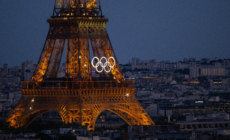-
Spaceman, Senator, V.P. Pick? Kamala Harris Sizes Up Mark Kelly. - 24 mins ago
-
Drinking Water Warning Issued for City in Kansas - 32 mins ago
-
Olympics News: Best Moments From the Opening Ceremony - about 1 hour ago
-
Opening Ceremony Misses the Boat - about 1 hour ago
-
Harvey Weinstein’s Medical Condition Takes Massive Turn - 2 hours ago
-
Vivian Jenna Wilson, Elon Musk’s Transgender Daughter, Says He Was ‘Cruel’ and ‘Uncaring’ - 2 hours ago
-
How to Watch Men’s Basketball at the 2024 Paris Olympics: Streams, Schedule - 2 hours ago
-
Trump, Honing Attacks on Harris, Casts Her as a Far-Left Threat - 3 hours ago
-
Woman Explains Why She Decided To Have Rescue Dog Euthanized Over Behavior - 3 hours ago
-
Justice Dept. Defends TikTok Law That Forces App’s Sale or Ban - 3 hours ago
Ukraine Fights to Hold Off Fierce Russian Assaults in Northeast
Ukrainian forces on Wednesday were putting up a fierce defense in Vovchansk, a village in northeastern Ukraine about five miles from the Russian border, engaging in what appeared to be street fighting as they tried to contain the Russian advance in the area.
In a sign of heightened concern over the deteriorating military situation, President Volodymyr Zelensky of Ukraine canceled his participation in all international events for the coming days, including a visit on Friday to Spain where he was expected to sign a bilateral security agreement.
Ukraine’s General Staff said in a statement that its forces had “partially pushed the enemy” out of Vovchansk. A few hours earlier, it had acknowledged that its troops had withdrawn from positions in two villages, including Vovchansk, allowing Russian forces to gain a foothold.
“Active fighting is ongoing,” Oleksiy Kharkivskiy, the police chief in Vovchansk, said on Wednesday in a video published on Facebook from the village, in which heavy gunfire could be heard in the background. He added that Russian troops had taken positions in several streets in the village and that the situation “is extremely difficult.”
Ukrainian officials and military analysts said Ukraine’s position on the battlefield in recent days has seriously worsened, as the government in Kyiv tries to repel a new Russian offensive push in the northeast that is stretching its already outnumbered and outgunned forces.
Russia has timed its new offensive, which started on Friday, at an opportune moment. Ukraine is short of manpower and is struggling to recruit more soldiers. It is also running out of ammunition because of delays in Western military aid, in particular America’s $60.8 billion package which was passed in Congress three weeks ago, after months of political wrangling.
Wrapping up a two-day visit to Kyiv, Secretary of State Antony J. Blinken said at a news conference on Wednesday that the U.S. was “rushing ammunition, armored vehicles, missiles, air defenses” to the front lines.
Mr. Blinken added that the Biden administration had allocated $2 billion for Ukraine’s military, much of it to be invested in the country’s defense-industrial base to help Ukraine produce its own weapons over the long term.
Ukrainian officials and military analysts say that Russia’s Army now appears to be advancing more slowly in the northeast, six days into its offensive, partly because they have reached more urbanized areas, like Vovchansk, which makes rapid progress more difficult.
Gen. Kyrylo Budanov, the head of Ukraine’s military intelligence agency, told Ukrainian television on Tuesday that conditions in the area under attack were moving “toward stabilization,” with additional Ukrainian units being rushed in to repel Russian advances. But he added that “the situation is quite tense and is changing very quickly.”
The assessments by the Ukrainian officials and analysts appeared to be supported by open-source maps of the battlefield compiled by independent groups analyzing combat footage. Those maps showed that Russian troops had gained footholds in two settlements in the past day, a slower rate of advance than before, when they were capturing up to five settlements a day.
Russia’s Ministry of Defense said on Wednesday that it had captured two settlements in the northeast, a claim that could not be independently confirmed and did not match what the open-source maps showed.
Russia also said it had seized the village of Robotyne in the south. The claim could also not been independently verified and Ukrainian officials denied it. Robotyne was recaptured by Ukrainian troops last summer, in one of the few gains of Ukraine’s unsuccessful counteroffensive at the time. Should it fall back into Russian hands, it could deal a blow to the morale of the Ukrainian Army.
Vovchansk has been heavily bombed since the start of Russia’s offensive operations on Friday, including with powerful guided weapons known as glide bombs that deliver hundreds of pounds of explosives in a single blast. Almost all the residents of the village, which had a prewar population of 17,000, have fled, local authorities said.
Oleh Syniehubov, the head of the Kharkiv region’s military administration, said on Wednesday that nearly 8,000 civilians had been evacuated from villages and settlements in the region. These include residents of villages on the immediate outskirts of Kharkiv that have come under increasing shelling in recent days.
Krystyna Havran, a member of the village council of Lyptsi, about 10 miles north of Kharkiv’s outer ring, said she had been scrambling to evacuate residents in recent days as the fighting got closer. “No one imagined that there would be an offensive,” she said.
Most of the evacuees have streamed into Kharkiv, hoping that the city, Ukraine’s second largest after the capital, Kyiv, would provide them with more security. But Kharkiv has been the target of numerous Russian airstrikes for several weeks, making life for its residents increasingly difficult.
Mr. Syniehubov said that Kharkiv had been targeted six times on Tuesday, including with glide bombs that hit the northern part of the city, causing heavy damage to a 12-story apartment building and injuring 22 people. A video released by the national police shows officers walking on piles of rubble inside a building and firefighters putting out a blaze.
Mykola Bielieskov, a military analyst at the government-run National Institute for Strategic Studies in Ukraine, said the strikes were designed “to instill fear and make people flee from frontline urban areas.” But to force Kharkiv’s 1.2 million residents to flee, he added, Russia would have “to systematically target the city — weeks of strikes.”
Analysts say this could explain why Russia is pushing north of Kharkiv. If Russian troops secured positions in a village like Lyptsi, they would be within artillery range of the city, allowing them to pound it with shells.
Russia has also targeted power plants and substations in the Kharkiv region and other areas of Ukraine since March, part of a campaign to cut off electricity to large areas of the country and make life miserable for civilians.
The strikes have severely limited Ukraine’s available generating capacity. As a consequence, Ukrenergo, the country’s national transmission system operator, introduced emergency blackouts for households and businesses in several regions on Tuesday night and Wednesday morning, in an effort to save energy.
Power outages were limited in Kyiv, affecting only 10 percent of the consumers, according to local authorities. But Ukrenergo warned that new blackouts were likely to be introduced again on Wednesday night.
Ukrainian officials have urged their Western allies to provide them with more air defense weapons and ammunition to shoot down Russian missiles and drones. Dmytro Kuleba, Ukraine’s foreign minister, reiterated this demand during a meeting with Mr. Blinken on Wednesday, asking him to help Ukraine obtain more U.S.-made Patriot air defense systems.
Mr. Blinken also said that the U.S. and Ukraine were close to completing a security agreement, one of dozens that Kyiv is negotiating with NATO members as it lobbies for admission into the alliance. He said it could be signed “in a matter of weeks.” Such an agreement would not guarantee significant funding but would include things like intelligence sharing and military interoperability.
Michael Crowley and Daria Mitiuk contributed reporting from Kyiv.




















